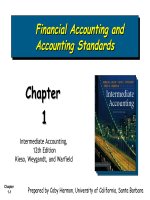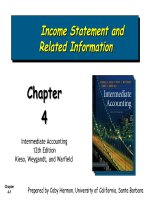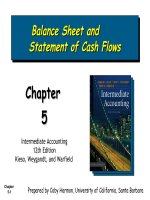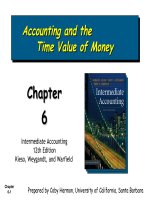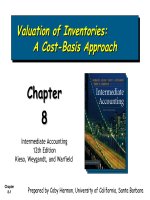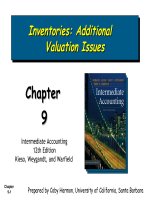Intermediate accounting IFRS edtion kieso weygrant warfield chapter 05
Bạn đang xem bản rút gọn của tài liệu. Xem và tải ngay bản đầy đủ của tài liệu tại đây (3.51 MB, 102 trang )
5-1
PREVIEW OF CHAPTER
5
Intermediate Accounting
IFRS 2nd Edition
Kieso, Weygandt, and Warfield
5-2
5
Statement of Financial Position
and Statement of Cash Flows
LEARNING OBJECTIVES
After studying this chapter, you should be able to:
1. Explain the uses and limitations of a
statement of financial position.
2. Identify the major classifications of the statement
of financial position.
3. Prepare a classified statement of financial
position using the report and account formats.
4. Indicate the purpose of the statement of cash
flows.
5. Identify the content of the statement of cash
flows.
5-3
6. Prepare a basic statement of cash flows.
7. Understand the usefulness of the statement
of cash flows.
8. Determine additional information requiring
note disclosure.
9. Describe the major disclosure techniques for
financial statements.
STATEMENT OF FINANCIAL POSITION
Statement of financial position, also referred to as the
balance sheet:
1. Reports assets, liabilities, and equity at a specific date.
2. Provides information about resources, obligations to
creditors, and equity in net resources.
3. Helps in predicting amounts, timing, and uncertainty of
future cash flows.
5-4
LO 1
STATEMENT OF FINANCIAL POSITION
Usefulness
Computing
rates of return.
Evaluating
the capital structure.
Assess
risk and future cash flows.
Assess
the company’s:
►Liquidity,
►Solvency,
►Financial
5-5
and
flexibility.
LO 1
STATEMENT OF FINANCIAL POSITION
Limitations
Most
assets and liabilities are reported at historical
cost.
Use
of judgments and estimates.
Many
items of financial value
are omitted.
5-6
LO 1
5
Statement of Financial Position
and Statement of Cash Flows
LEARNING OBJECTIVES
After studying this chapter, you should be able to:
1. Explain the uses and limitations of a statement of
financial position.
2. Identify the major classifications of the
statement of financial position.
3. Prepare a classified statement of financial
position using the report and account formats.
4. Indicate the purpose of the statement of cash
flows.
5. Identify the content of the statement of cash
flows.
5-7
6. Prepare a basic statement of cash flows.
7. Understand the usefulness of the statement
of cash flows.
8. Determine additional information requiring
note disclosure.
9. Describe the major disclosure techniques for
financial statements.
CLASSIFICATION IN THE STATEMENT
Elements of the Statement of Financial Position
ASSET
5-8
LIABILITY
EQUITY
Resource controlled by the entity.
Result of past events.
Future economic benefits are expected to flow to the
entity.
LO 2
CLASSIFICATION IN THE STATEMENT
Elements of the Statement of Financial Position
ASSET
5-9
LIABILITY
EQUITY
Present obligation of the entity.
Arising from past events.
Settlement is expected to result in an outflow of
resources embodying economic benefits.
LO 2
CLASSIFICATION IN THE STATEMENT
Elements of the Statement of Financial Position
ASSET
5-10
LIABILITY
EQUITY
Residual interest in the assets of the entity after
deducting all its liabilities.
LO 2
CLASSIFICATION IN THE STATEMENT
Subclassifications
ILLUSTRATION 5-1
Statement of Financial
Position Classification
A recent survey shows that companies are moving toward reporting current
assets first on the statement of financial position, which is a change from a few
years ago.
5-11
LO 2
CLASSIFICATION IN THE STATEMENT
Non-Current Assets
Generally consists of:
Long-term
Property,
Investments
Plant, and Equipment
Intangibles Assets
Other Assets
5-12
LO 2
CLASSIFICATION IN THE STATEMENT
Long-term Investments
1.Securities (bonds, ordinary shares, or long-term notes).
2.Tangible assets not currently used in operations (land held
for speculation).
3.Special funds (sinking fund, pension fund, or plant
expansion fund).
4.Non-consolidated subsidiaries or associated companies.
5-13
LO 2
CLASSIFICATION IN THE STATEMENT
Investments in Debt and Equity Securities
Portfolio
Held-forCollection
Trading
Non-Trading
Equity
5-14
Valuation
Classification
Debt
Amortized Cost
Current or
Non-current
Debt or Equity
Fair Value
Current
Fair Value
Current or
Non-current
Type
Equity
LO 2
CLASSIFICATION IN THE STATEMENT
Long-Term Investments
5-15
ILLUSTRATION 5-17
Classified Report-Form
Statement of Financial
Position
LO 2
CLASSIFICATION IN THE STATEMENT
Property, Plant, and Equipment
Tangible long-lived assets used in the regular operations of
the business.
Physical
property such as land, buildings, machinery,
furniture, tools, and wasting resources (minerals).
With
the exception of land, a company either depreciates
(e.g., buildings) or depletes (e.g., oil reserves) these
assets.
5-16
LO 2
CLASSIFICATION IN THE STATEMENT
Property, Plant, and Equipment
5-17
ILLUSTRATION 5-17
Classified Report-Form
Statement of Financial
Position
LO 2
CLASSIFICATION IN THE STATEMENT
Intangible Assets
Lack physical substance and are not financial instruments.
5-18
Patents, copyrights, franchises, goodwill, trademarks,
trade names, and customer lists.
Amortize limited-life intangible assets over their useful
lives.
Periodically assess indefinite-life intangibles for
impairment.
LO 2
Intangible Assets
5-19
ILLUSTRATION 5-17
Classified Report-Form
Statement of Financial Position
LO 2
CLASSIFICATION IN THE STATEMENT
Other Assets
Items vary in practice. Can include:
5-20
Long-term prepaid expenses
Non-current receivables
Assets in special funds
Property held for sale
Restricted cash or securities
LO 2
CLASSIFICATION IN THE STATEMENT
Current Assets
Cash and other assets a company expects to convert
into cash, sell, or consume either in one year or in the
ILLUSTRATION 5-5
operating cycle, whichever is longer.
Current Assets and
Basis of Valuation
5-21
LO 2
CLASSIFICATION IN THE STATEMENT
Inventories
Disclose:
5-22
Basis of valuation (e.g., lower-of-cost-or-net realizable
value).
Cost flow assumption (e.g., FIFO or average cost).
LO 2
Inventories
5-23
ILLUSTRATION 5-17
Classified Report-Form
Statement of Financial Position
LO 2
CLASSIFICATION IN THE STATEMENT
Receivables
Major categories of receivables should be shown in the
balance sheet or the related notes.
A company should clearly identify
Anticipated
Amount
loss due to uncollectibles.
and nature of any non-trade receivables.
Receivables
5-24
used as collateral.
LO 2
Receivables
5-25
ILLUSTRATION 5-17
Classified Report-Form
Statement of Financial Position
LO 2
